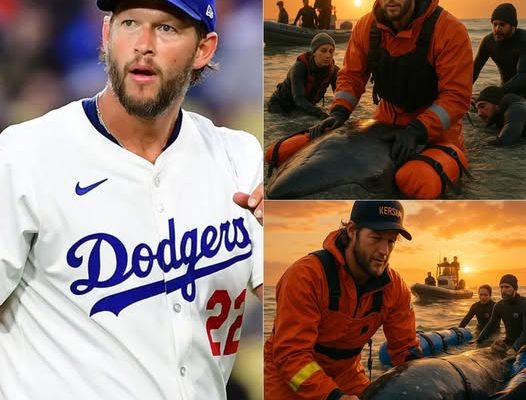Clayton Kershaw has been the face of Major League Baseball’s pitching greatness for over a decade, carving his name into the hearts of millions with a fastball that defies logic and a curveball that seems to bend time. But what he did this summer, far away from the diamond and lights, transcends any feat he has accomplished in Dodger blue. The three-time Cy Young Award winner and 2014 NL MVP just stunned the world in a way nobody saw coming—not with a pitch, but with a purpose. In a move that shocked fans, conservationists, and the broader sports world, Kershaw recently led and personally funded a high-stakes marine rescue mission to save injured whales off the coast of California, pledging $2 million of his own money, lending his voice to a national campaign, and working directly with conservation teams. “The ocean wouldn’t be as magical without whales,” he said, voice cracking during a brief but emotionally charged press appearance, his Dodger cap pulled low as he spoke not about ERA or postseason pressure, but about life beneath the sea.
It all started with a chance encounter during an offseason fishing trip. Kershaw, who spends part of his offseason in the coastal stretches of Santa Barbara, was out on the water with family and friends when they came across a severely injured humpback whale entangled in fishing gear and bleeding from lacerations caused by illegal drift nets. The scene, which he later described as “like watching agony unfold in slow motion,” stuck with him. Despite calling for help, it took hours for trained marine biologists to arrive. By that time, the whale had begun to show signs of distress that are typically precursors to death. Though the team was able to cut it free and guide it back into deeper waters, the animal’s fate remained uncertain. That moment sparked a fire in Kershaw. What began as grief turned into a commitment to change what he called “a broken system in the way we treat our oceans.”
Back in Los Angeles, Kershaw immersed himself in marine biology research, holding private meetings with scientists from the National Oceanic and Atmospheric Administration (NOAA), as well as activists from nonprofit groups like the Whale and Dolphin Conservation (WDC) and Oceanic Preservation Society. Within weeks, he had made his first significant donation—$2 million toward new technology aimed at tracking and intercepting ghost nets and illegal fishing equipment that threaten whales and other marine mammals along U.S. coasts. What made this donation unique wasn’t just the size, but the strings he attached: Kershaw required that at least $500,000 go toward on-the-ground rescue training and equipment for volunteers, and he himself began training with two veteran marine responders. The image of Clayton Kershaw donning a wetsuit and boarding a rescue vessel became iconic almost overnight. It was surreal. The man whose left arm terrified batters was now using it to help lift satellite tags, hoist ropes, and assist biologists in guiding whales to safety.
But the impact didn’t stop at sea. Using his star power, Kershaw teamed up with several MLB stars and celebrity allies to launch a campaign titled #SaveTheGiants, a social media initiative aimed at educating the public about whale conservation, dangers of ship strikes, underwater noise pollution, and the looming threat of climate change on migratory patterns. Within 72 hours of the launch, the campaign had reached more than 48 million people across platforms, buoyed by video footage of Kershaw on rescue boats, raw images of entangled whales, and personal testimonies from marine biologists. It has since become the most successful athlete-led conservation campaign since Leonardo DiCaprio’s Save the Elephants campaign a decade ago. Donations to marine wildlife organizations spiked nearly 300% following the campaign’s viral spread, and new legislation is already being considered in California that would require fishing companies to use safer, whale-friendly equipment in known migratory zones.
What makes this all the more astonishing is that Clayton Kershaw has never been associated with activism on this scale. While he and his wife Ellen have long supported children’s charities through their organization “Kershaw’s Challenge,” the turn toward marine advocacy was not only unexpected but almost unprecedented in modern sports. Many professional athletes use their platforms to push for political or social causes—but rare is the figure who steps out of their world entirely to physically engage with an unfamiliar crisis, learn its intricacies, and then become a face of change. That’s exactly what Kershaw has done. When reporters asked what pushed him into action, his answer was direct and disarming: “You see something hurting and you help. That’s it. You don’t need a reason beyond that.”
Yet the reaction has been anything but simple. Kershaw’s sudden visibility in the marine conservation space has ignited both support and controversy. While most fans and environmentalists have praised his passion and commitment, critics within the political space have called his efforts “performative” or “misguided,” arguing that systemic change should be led by policy experts, not athletes. Kershaw, however, has remained unfazed. “This isn’t about being a hero. It’s about doing what you can with what you have. I happen to have a loud microphone, and I plan to use it until people listen.”
Perhaps what’s most poignant is that the whale that launched this all—the one he encountered during his fishing trip—was recently spotted by a NOAA drone about 30 miles offshore, swimming freely and appearing to have recovered. The organization confirmed through satellite tagging that the animal had not only survived but had also begun its annual migration north. When Kershaw was shown the footage during an interview, he reportedly wept and said simply, “That’s what it’s all about.”
Since the launch of #SaveTheGiants, MLB itself has stepped in to offer support. Several teams now feature pregame PSAs on jumbotron screens promoting ocean safety, and select stadiums have begun donating portions of ticket sales to marine preservation efforts. The Dodgers, true to their tradition of honoring their legends while they’re still active, announced plans to host a “Whale Night” next season, with a portion of proceeds benefiting Kershaw’s chosen nonprofits. Fans will receive commemorative gear emblazoned with a custom logo featuring Kershaw’s silhouette beside a breaching humpback whale. It’s marketing with meaning, but more importantly, it’s momentum.



